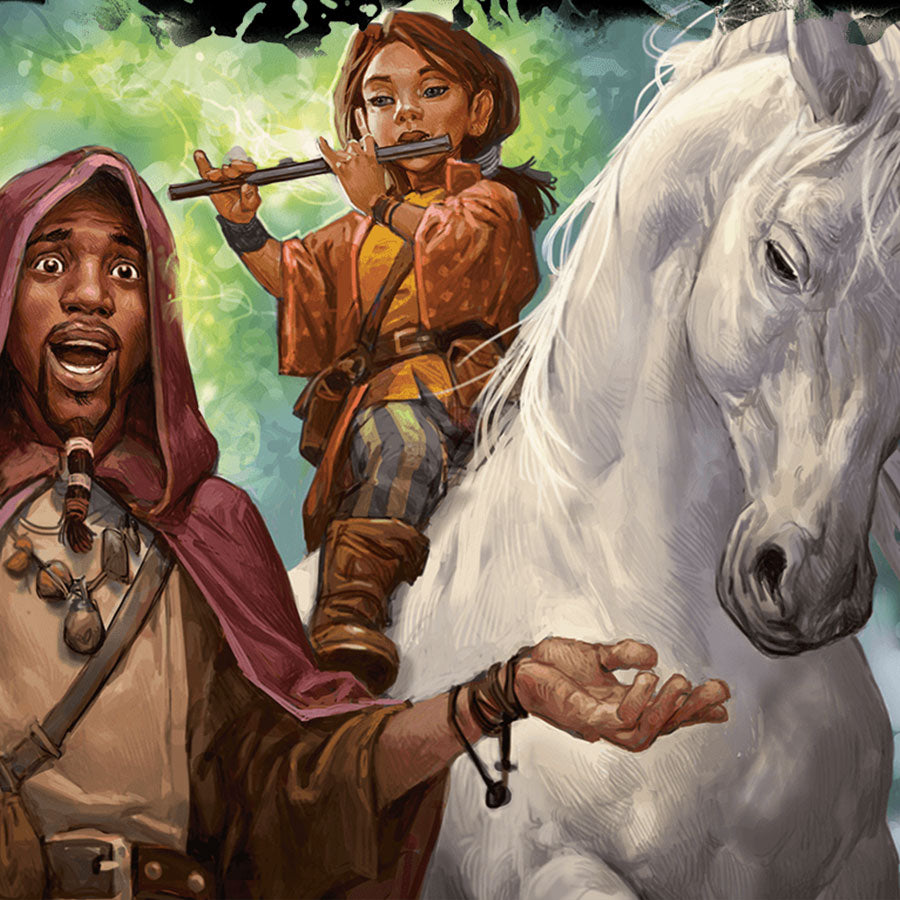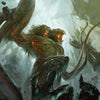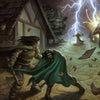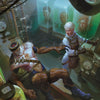How to Run Social Adventures in D&D

Written by Luke Hart
Many gaming groups love combat. And that should come as no surprise the sense over half of most player handbooks are dedicated to combat rules, and one of the three core books is almost always a monster manual with stat blocks that are mostly used for combat.
However what if you and your friends don't enjoy combat? Or what if you want to create an adventure that minimizes combat or doesn't include it at all? What do you do then?
Your first instinct may be to build into every encounter ways the characters to resolve the situation without combat, perhaps even creating specific mechanics to do so. And then you figure hey the option exists to resolve this without combat, surely, they will pursue it. But what happens when they don't? Or what happens when the way to resolve this situation without combat is more complex or tedious than simply resorting to violence? And if you’re using experience points, and you don't award full experience points for non-combat solutions to encounters, then your players are probably going to be skewed toward resolving everything with violence because they want to level up.
So, you throw all of that out the window, and you decide that you are going to create a social adventure where combat cannot be a solution to the majority of the encounters. That is getting into fights will be a failure state. But how do you create an adventure like that?
Examples of these sorts of adventures abound.
The characters are invited to a masquerade ball where they must uncover a thief before the night is over. They need to get their clues, interview guests, and solve puzzles without drawing too much attention.
The characters are on a diplomatic mission where they must broker peace between two warring factions. They need to navigate political intrigue, uncover hidden agendas, and use their skills of persuasion to reach a mutually beneficial agreement.
Or during a yearly festival the characters must help reunite families with their lost loved ones’ spirits. They may engage in various festival activities, assist with rituals, and uncover the history and emotions behind each spirit's lingering presence.
The fact is, that you create social adventures like these, you need to use a completely different adventure development methodology. Most dungeon masters are probably accustomed to creating or running location based adventures. Location based adventures are your typical dungeon delve style which make up 90% or more of pre-published adventures out there. And that design methodology is just not going to work for a social adventure.
Instead, you're going to want to create an event-based adventure. An event based adventure is a nonlinear adventure based around an event or series of events rather than in a specific location or “dungeon”. Social adventures will generally occur in a specific location, however that location is not populated with monsters and treasure but with people who are involved in some sort of social exchange. Well, there could be monsters and treasure, but they're going to be implemented in a much different way than a typical dungeon delve.
By the way, I have an entire video about creating event-based adventures if you want to check that out later.
What I'm going to do now is breakdown how to create a social adventure in 10 steps, which don’t have to happen in order. In fact, sometimes the different steps will happen in parallel.
We’ll also be creating the framework of a sample social adventure to illustrate the steps. In this adventure, the characters will be tasked with attending Lady Rosette Kirkland’s masquerade ball in order to discover who the secret leader of a Cult of Mammon is. And if you'd like, please feel free to steal this adventure for your own game!
Watch or listen to this article by clicking the video below.
#1 Create the Villain
For most social adventures, the goal is not to confront a single villain, but rather to do something without being discovered because that would result in combat. Social adventures, therefore, often have multiple "villains," though these villains serve more as sources of challenge than sources of confrontation.
For our sample social adventure, we’ll have four key villains.
Andrev DeWitt, a local lord with a string of wealthy wives who all died under mysterious circumstances. He is the secret leader of the Cult of Mammon—the archdevil of greed—which is operating in the city.
Alton Davenport, an up and coming young noble who has recently come into a lot of money, but nobody knows how.
Rosette Kirkland, a local baroness and host of the social event, in this case a masquerade ball, who was recently widowed when her husband was killed in a hunting accident.
Preston Allencort III, a local lord and merchant guild leader who is a distant cousin of the king. (By the way, being related to the ruler of the nation in which a social adventure takes place almost always results in players being suspicious of that character even if there is no other "hook" to imply their potential villainy. Players are a suspicious lot. So, we’re planting Preston here on purpose to fuel the flames a bit.)
We aren't going to flesh out all of the details about our villains in this step, however. Instead I'm going to address how to do that in Step 4. Right now it is sufficient to establish who the villains are. We will get to their motivations and goals in just a little bit.
Now, because combat is not going to be a real option in this adventure, we don't really need to have full stat blocks for every villain. However you know your players best. And it's possible your players love themselves a good fight and they're probably gonna start something with someone at some point. So if you think you'll need stat blocks, go for it.
#2 Create the Plot
Every adventure needs a plot, and none more so than a social adventure because that plot is going to be the game master's point of reference for running the adventure and keeping things moving.
If you look at your typical location-based adventure, because there are corridors and rooms with things in them and typically monsters here and there to fight, even if there isn't a strong plot, the adventure kind of runs itself because your players just push forward to the next room and then the next room after that one. And everything just works itself out. This is probably the reason the majority of published adventures out there are location based adventures. Not only are they easier to run as a game master, but they are also easier to write and publish.
Something else that you're going to find is that social adventures can very easily fall into meandering sessions of the characters talking to every NPC they meet without making any progress toward their goal. And this will especially be true if your players just love talking to NPC's. However, if you have a strong plot, that enables you as the dungeon master to keep redirecting your players toward their objective, and driving the action forward.
The first thing that you need to create is the goal, this specific thing that the characters need to achieve in order to complete the adventure. In many social adventures, the plot involves a heist of some sort such as stealing a painting, a weapon, or helping a prisoner escape. Another popular social adventure is the murder mystery, where something happens at a social event that forces the characters into action.
Now in our sample social adventure, we are going to look at a different kind of social adventure where the goal is also social in a manner of speaking. The characters are there to get information critical to the campaign from the NPCS. In our adventure, the characters have come to lady kirkland's annual masquerade ball to uncover the identity of the leader of the cult of mammon. They're not there to confront or fight that villain. They just need to determine their identity so that they can confront them later in a more suitable environment.
Any social adventure, it is critical that the players have a clear understanding of their goal! If they don't understand what the goal is and have a common purpose and direction, your adventure is far more likely to devolve into a meandering session of talkie talkie bits with no real progress and no resolution.
#3 Determine the Inciting Incident
In the case of a social adventure, the inciting incident is usually the social event itself and the goal. So simply ask yourself, how do the characters come to learn of the event and tie it to their goal? Once you know this you have the inciting incident.
In our example, one of the characters is conveniently from a noble background and learned of the masquerade ball through normal channels. They may have even received an invitation because of their social status. Or the group itself might have received an invitation because of their previous exploits. After all a successful group of adventurers is very in style to have as guests to entertain your real guests.
Now, the characters know that someone among the nobility is backing the cult of mannon, but they haven't been able to figure out exactly who that is. And this masquerade ball is their chance to uncover that information.
#4 Determine and Flesh Out Key NPCs
For a social adventure, nothing is more important than fleshing out the NPC's that the characters will be interacting with. Why you might ask? Because NPC interaction forms the backbone of a social adventure. Yes there's probably gonna be some exploration as well, but by and large your players are probably going to be doing a lot of talkie talkie.
However, you only need to flesh out NPCS that are relevant to the goal of the adventure. You see, social adventures tend to have a lot of NPC's involved, especially in something like a masquerade ball. You do not need to create 300 NPC's in detail. Spend most of your planning time focusing on the important and PCs. However, because players are likely to interact with NPCs that are not relevant to the plot, it does help to have a list of NPC names and traits, quirks, and identifying markers that you can pull from at a moment's notice.
Now I've talked a lot about creating NPC's in the past, so i'm not going to deep dive on it right here. Instead, I'm going to focus on the aspects of NPC creation that are most critical for a social adventure.
First ask yourself what information the NPC has that will serve to advance the plot. What will they do to hold on to that information? What can the PCs do to obtain that information?
For Andrev DeWitt, the leader of the cult of mammon, he knows everything there is to know about the cult because, well, he's its leader. Lady Kirkland knows that DeWitt has some shady connections, But she doesn't know exactly who he's dealing with. She also believes that he is responsible for the death of his last wife who drowned mysteriously in the pond on his estate. However she won't give up that information easily because she is afraid of him.
Keep in mind that a high roll on an ability check doesn't mean that you have to give the characters the information. A social adventure should not devolve into a series of dice rolls that do not take into account what characters actually say. For social adventures what the characters actually say to NPC's should heavily influence how an NPC reacts and what if any information they give them. You might, however, use good results on skill checks to give the players a hint as to what they might say or do to get the information. My point is that if you are running a talkie talkie sort of adventure, make sure that the talking actually matters!
Next, determine what the NPCS starting attitude toward the characters is. Not every NPC should start out as hostile in fact, it's more common for NPC's to start out as neutral and only become a hostile if interactions drive things that way. However, an NPC who does have a reason to dislike the characters should begin with a hostile attitude. In the case of the main villain, Andrev DeWitt, he is hostile toward the characters who have been interfering with his plans for some time now. However, he doesn't want to appear openly hostile, so he'll do his best to play nice, even though he can't resist the occasional snide comment or remark.
Other NPCS might be downright friendly if they think they can get something out of their characters. Lady Kirkland, for instance, is openly friendly to the characters because she views them as a novel source of entertainment that can elevate her masquerade ball above all of the other nobles, possibly even increasing her status in the noble pecking order.
Speaking of getting something out of the characters, identify what the NPC wants. Everybody wants something, and social events are often a good way to achieve those goals. In fact, it works out best if what the NPC wants can be obtained during the adventure. This gives players something that they can use, but also keeps the NPC's desire relevant to the event.
For instance Alton Davenport wants to blackmail lady Kirkland, but he can't prove she's guilty of anything, so he's looking for evidence. Lord Preston Allencourt III is being blackmailed by alternate Davenport and he wants proof that Davenport is blackmailing him.
What is the NPC afraid of? Fear is a great motivator. An NPC that is afraid of something, is an NPC the characters can gain leverage on. Again it works best if that fear is something that can be taken advantage of At the event the adventure takes place during.
Lady Kirkland is afraid the someone is after her family's wealth, and that she has a target on her back. After all her husband's death on his hunting trip was very suspicious. Preston Allencourt has been supporting the local bandit gang for decades, providing them with caravan routes for a cut of the profits, and even helping them hide from the law. His biggest fear is this information becoming public and destroying his life. And that, of course, is exactly what Alton Davenport is using to blackmail him.
Finally, consider what the NPC is hiding. What is their secret? Each key and PC should have something that they don't want others to know. This can be as simple as what they want or what their fear is. However, the secret should absolutely be relevant to the adventure.
Lady Kirkland had a secret child before she was married to Lord Kirkland. She doesn't know the child's identity as he was immediately sent to an orphanage by her father, however unbeknownst to her, her son is at the party. Alton Davenport, our blackmailer, doesn't want anyone to know how he got his money. He wants to be seen as a successful businessman, and wants the nobility to accept him as one of their own, Even if he is new money.
#5 Plan Events
While the characters should drive the plot forward, you're going to need some events that will keep the story moving and help the characters reach their goal, or perhaps complicate things a bit. This will be a simple list of events that will drive the story beyond what the characters choose to do, and many times you'll want these to be timed events that happened in a specific order, though you don't have to do that.
Here are the events for our adventure.
At 7:00 PM the party starts. Lady Kirkland makes a speech welcoming everyone. She jokes that they should all remember that this is a masquerade ball and that they shouldn't tell anyone who they really are. This is despite the fact than in most medieval masquerades, most people's identities were obvious as they were well known shakers and movers.
At 7:30 PM, Lord Allancourt and Alton Davenport have a confrontation that causes a minor scene.
At 8:00 PM, if the characters haven't approached lord dewitt, he approaches them. He wants to subtly find out why they're here. Remember Lord DeWitt is our villain, the leader of the cult of mammon, and he doesn't want anyone to discover that.
Around 9:00 PM, the game master insurers that Lord DeWitt, Alton Davenport, and Lord Allancourt are all out of view for several minutes.
10 minutes later, there is a scream from the garden. Lord Allencourt has been stabbed to death. In his blood on the cobblestones he wrote the letters A D.
At 1:00 AM, the party ends.
This is a short basic list, of course, that you could expand as desired. This list of events could also include encounters, but we're breaking those apart into our next step.
#6 Plan Encounters
Encounters in a social adventure are not combat, but each one should raise the stakes or provide some sort of twist to the plot or adventure. Now, some encounters could be timed to happen at certain points in the adventure. Others could work on triggers. This is when the game master prepares the encounter to only happen if the characters go somewhere or do something.
Here are some examples of common encounters for social adventures. An NPC that the characters thought was dead shows up at the event. An NPC that knows the characters and could accidentally expose their plan arrives. An event, such as Lord Allancourt's murder, causes a series of related encounters such as city guards questioning witnesses. Rival NPC's, another adventuring group, who are after the same thing as the characters begin to make their move. Any other kind of social trap will work as well. A social trap puts the characters in a position where they have to choose between creating a scene or making some other social faux pas that will affect their chances of success or outright putting their mission on the back burner for a short time.
Encounters can also be as simple as planned snippets of conversation that the characters can overhear that will serve to either help or hinder the pursuit of their goal.
Now, it's quite possible as well that the encounters you plan will take place during some of the events that you have planned out. So, your encounters and events may end up working hand in hand. In fact at some point you're probably going to start to feel like the distinction between an event and an encounter is very small. And, honestly, it probably is.
#7 Plan the Location
Many social adventures take place in a single location. However that location could have other locations within it.
In our masquerade ball, we have the following important locations to flesh out and describe. The ballroom where most of the action will take place. The smoking room where pipes and cigars are all the rage among the gentlemen. The gardens where Lord Allancourt will be murdered. The upstairs walkway and balcony from where the party can be observed. And finally Lord Kirkland's office where his partnership with Allencourt and his other dealings can be discovered, as well as lady Kirkland's notes on her investigations into his death—which could be misinterpreted as her planning his murder.
Eyes flushing out a description and other relevant details of each location, you should have at least one encounter planned for each of your key locations.
#8 Plan the Climax
The climax is the climatic event that leads to the adventures resolution, and you should plan for it. Now this is harder to do for a social adventure, because it may not involve combat and may very well not even be noticed by the villain or other key entities.
For instance, when the characters discover that Lord DeWitt is the leader of the cult of mammon, no one is likely to notice that are they? And the grand revelation maybe accompanied by very little fanfare. However, I do recommend some kind of action or event to accompany the climax so that your players will feel rewarded for their achievement.
For our adventure, we’ll considering things like this. What will Lord DeWitt do if the characters reveal his involvement in the cult to other people at the masquerade ball? What will he do if he discovers that the characters should know that he is the leader of the cult? What will he do if he's exposed as Lord Allencourts murderer? Will he run? Will he attack? Does he have cultists hidden among the crowd that attack while he makes his escape? Will someone else learn what's going on and intervene to prevent the characters from making a scene?
#9 Plan the Resolution
Once the characters achieve their goal, how will the adventure be wrapped up?
The party ends at 1:00 AM if there hasn't been any crazy confrontation that ruins the masquerade ball, but it ends earlier if there is a fight, or perhaps it ends after lord Allancourt's murder. But how will lady Kirkland react to having her party disrupted? How will the other key NPCS react after the masquerade ball and after the characters have used their wants or fears against them? Will there be future consequences in the coming weeks? Were any of the NPC's secrets exposed? If so how do they react?
Aside from achieving the goal and considering any immediate effects or future consequences, is there any other reward to be handed out? Is there gold treasure? If they helped one of the NPCS obtain something they wanted, will that NPC reward them?
Now, golden treasure are perhaps not as common for social adventures, but if the party was paid to undertake the adventure, there are still rewards to be had.
#10 Run the Adventure
Now, there are a few very important things for you to remember when you're running a social adventure.
Number one, set the tone. Since this is a social adventure, not a combat based adventure, you need to emphasize that and set the tone accordingly. It's quite possible that characters may not have access to their weapons and armor or other adventuring equipment, except what they can sneak in hidden on their persons.
#2, players should have time to form a plan. And if players don't seem like they're planning, you should encourage them to form a plan, even if you know that plan is going to go off the rails at some point as most plans do. You see, if the players don't have a plan, the adventure will have a much higher chance of meandering and falling flat.
#3, focus on difficulty classes, not armor classes. And what I mean here is that you should have a rough idea of the difficulty class range you're going to be using for any skill checks that characters make during your adventure. And this will probably change from NPC to NPC, and depend upon what the characters are trying to achieve. I suggest not setting specific DC's up in advance, but just having an idea of what the range should be. Then when you're running the adventure you can set specific DCS up on the fly as they become relevant based upon circumstances. This is very easy to do and greatly reduces your prep time.
#4, NPC attitudes should not instantly change. Any given social encounter should only be able to shift an NPC's attitude by one level towards helpful. This makes the players have to work a little harder to succeed and keeps the adventure going.
#5, you're going to have to manage the conflicting agendas and plans of the NPCS. This should be planned in steps 5 through 9, but they need to be remembered and executed as part of running the adventure. It's important that the event seems to be alive and NPCs keep moving forward according to their own goals and motivations, even if the players begin to meander or stall.
Number six, you, the dungeon master, call for roles. The players don't just roll dice and tell you what they were doing. This is even more important during a social adventure because roles should only be required when necessary. They should only be rolled when there is a reasonable chance of success or failure. And failure should only matter if there is a reasonable consequence to that failure.
#7, finally and most importantly remember that this is a group game, and make sure the players remember that as well. Every player and character should be allowed to share an equal part in playing the adventure, not just those with high charisma skills. Success or failure in social adventures should not solely depend or revolve around the most charismatic players, or the most charismatic characters. In order to achieve this, during your planning you should make sure to plan something for every character to encounter or a way for them to become involved in the adventure.
Leaning on the high charisma characters for a social adventure, and having them by and large being the only players that are even playing the game, is a trap that players and game masters alike can easily fall into. Remember, this is a group game. Everyone should have a chance to engage with the adventure and have fun.
Get Loads of 5e Adventures and Resources for Your Games!
As a new dungeon master, I was overwhelmed with everything I needed to do. Learn the rules, create the adventures, run the game, handle problem players—it was A LOT! And even as a veteran DM, it’s still a lot. You might even feel that way yourself.
If you’re looking for loads of 5e adventures that you can prep in under 30 minutes or elements such as traps, puzzles, and encounters that you can drag and drop into your game at a moment’s notice, we have you covered!
With Lairs & Legends and Loot & Lore, you’ll get over 700 pages of 5e resources:
- Twenty-nine 5e adventures spanning levels 1 to 15 and designed for groups of 4 to 6 players.
- Over 100 new creatures from CR 0 to CR 24.
- Adventure Ideas
- Encounters with Full-Color and Blackline Digital Maps
- Patrons & Factions
- Magic Items
- NPCs
- Puzzles
- Random Encounter Tables
- Random Tables
- Spells
- Subclasses
- Traps
- Villains
Everything is designed to be EASY TO USE and QUICK TO PREP for your game. Our goal is to make game masters’ lives easier, not more complex!
Don’t spend another moment frustrated and overwhelmed as a GM. Pick up the Lairs & Legends Ultimate Bundle today and find out how much easier being a GM can be!
-
Posted in
Game Master How-To Articles







